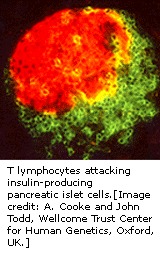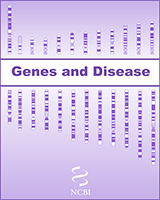NCBI Bookshelf. A service of the National Library of Medicine, National Institutes of Health.
National Center for Biotechnology Information (US). Genes and Disease [Internet]. Bethesda (MD): National Center for Biotechnology Information (US); 1998-.

Diabetes is a chronic metabolic disorder that adversely affects the body's ability to manufacture and use insulin, a hormone necessary for the conversion of food into energy. The disease greatly increases the risk of blindness, heart disease, kidney failure, neurological disease, and other conditions for the approximately 16 million Americans who are affected by it. Type 1, or juvenile onset diabetes, is the more severe form of the illness.
Type 1 diabetes is what is known as a 'complex trait', which means that mutations in several genes likely contribute to the disease. For example, it is now known that the insulin-dependent diabetes mellitus (IDDM1) locus on chromosome 6 may harbor at least one susceptibility gene for Type 1 diabetes. Exactly how a mutation at this locus adds to patient risk is not clear, although a gene maps to the region of chromosome 6 that also has genes for antigens (the molecules that normally tell the immune system not to attack itself). In Type 1 diabetes, the body's immune system mounts an immunological assault on its own insulin and the pancreatic cells that manufacture it. However, the mechanism of how this happens is not yet understood.
About 10 loci in the human genome have now been found that seem to confer susceptibility to Type 1 diabetes. Among these are 1) a gene at the locus IDDM2 on chromosome 11 and 2) the gene for glucokinase (GCK), an enzyme that is key to glucose metabolism which helps modulate insulin secretion, on chromosome 7.
Conscientious patient care and daily insulin dosages can keep patients comparatively healthy. But in order to prevent the immunoresponses that often cause diabetes, we will need to experiment further with mouse models of the disease and advance our understanding of how genes on other chromosomes might add to a patient's risk of diabetes.
- Genome view see gene locations
- Entrez Gene collection of gene-related information
- BLink related sequences in different organisms
- Research articles online full text
- Books online books section
- OMIM catalog of human genes and disorders
- Patient information on diabetes from the National Institute of Diabetes and Digestive and Kidney Diseases, NIH
- Juvenile Diabetes Research Foundation International 'dedicated to finding a cure'
- American Diabetes Association research and information
- Diabetes, type 1 - Genes and DiseaseDiabetes, type 1 - Genes and Disease
Your browsing activity is empty.
Activity recording is turned off.
See more...
